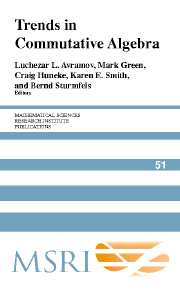Book contents
- Frontmatter
- Contents
- Preface
- Commutative Algebra in the Cohomology of Groups
- Modules and Cohomology over Group Algebras
- An Informal Introduction to Multiplier Ideals
- Lectures on the Geometry of Syzygies
- Commutative Algebra of n Points in the Plane
- Tight Closure Theory and Characteristic p Methods
- Monomial Ideals, Binomial Ideals, Polynomial Ideals
- Some Facts About Canonical Subalgebra Bases
Monomial Ideals, Binomial Ideals, Polynomial Ideals
Published online by Cambridge University Press: 06 July 2010
- Frontmatter
- Contents
- Preface
- Commutative Algebra in the Cohomology of Groups
- Modules and Cohomology over Group Algebras
- An Informal Introduction to Multiplier Ideals
- Lectures on the Geometry of Syzygies
- Commutative Algebra of n Points in the Plane
- Tight Closure Theory and Characteristic p Methods
- Monomial Ideals, Binomial Ideals, Polynomial Ideals
- Some Facts About Canonical Subalgebra Bases
Summary
Abstract. These lectures provide a glimpse of the applications of toric geometry to singularity theory. They illustrate some ideas and results of commutative algebra by showing the form which they take for very simple ideals of polynomial rings: monomial or binomial ideals, which can be understood combinatorially. Some combinatorial facts are the expression for monomial or binomial ideals of general results of commutative algebra or algebraic geometry such as resolution of singularities or the Briançon–Skoda theorem. In the opposite direction, there are methods that allow one to prove results about fairly general ideals by continuously specializing them to monomial or binomial ideals.
Introduction
Let k be a field. We denote by k[u1, …, ud] the polynomial ring in d variables, and by k〚u1, …, ud〛 the power series ring.
If d = 1, given two monomials um, un, one divides the other, so that if m > n, say, a binomial um – λun = un(um−n – λ) with λ ∈ k* is, viewed now in k〚u〛, a monomial times a unit. For the same reason any series ∑ifiui ∈ k〚u〛 is the product of a monomial un, n ≥ 0, by a unit of k〚u〛. Staying in k[u], we can also view our binomial as the product of a monomial and a cyclic polynomial um−n – λ.
For d = 2, working in k〚u1, u2〛, we meet a serious difficulty: a series in two variables does not necessarily have a dominant term (a term that divides all others).
- Type
- Chapter
- Information
- Trends in Commutative Algebra , pp. 211 - 246Publisher: Cambridge University PressPrint publication year: 2004
- 15
- Cited by

